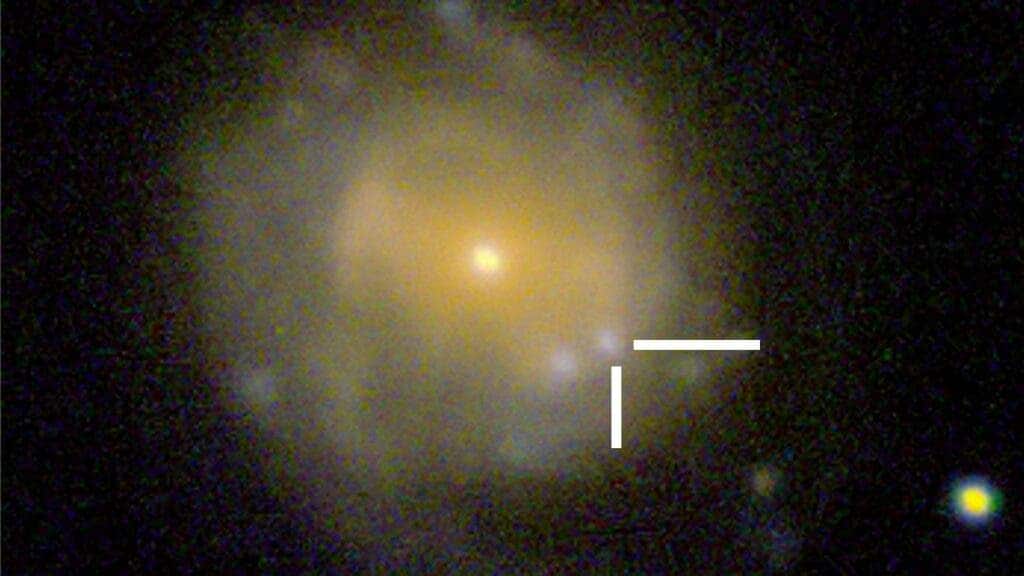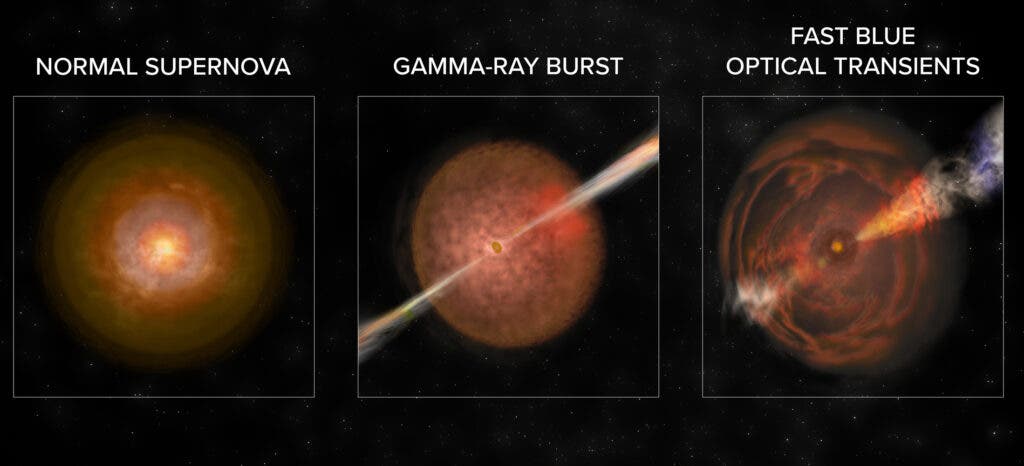June 16th 2022 may pass unremarked by the vast majority of astronomers and scientists, but for a small group of researchers, that day will mark the fourth anniversary of the discovery of a powerful, bright astronomical phenomenon, one which still confuses and puzzles them to this day. That is because, on June 16th, 2018, astronomers spotted a brief and unusual flash of light in the sky which came to be designated AT2018cow. The event nicknamed “the Cow” after the last three letters in its designation–a complete coincidence– was unlike any celestial outburst ever spotted before.
In the four years that have passed since the Cow was first spotted, astronomers have discovered that it was the first example of a type of cosmic outburst called a “Fast Blue Optical Transient” or an FBOT. And since the discovery of this new form of transient –an object or event in astronomy that brightens and fades over a period of time– only a handful of other “cows” have been uncovered.
Yet, despite the discovery of more of these cosmic events–so hot that they glow blue– astronomers and astrophysicists are still uncertain of their cause. And the mystery surrounding these events has only deepened with the realization that some FBOTs are as powerful as explosions that launch gamma-ray bursts but are characteristically distinct from these and other supernova explosions despite some other similarities.
Not only are FBOTs the brightest known optical phenomena, but their optical display is also rapidly followed by emissions in the X-ray region of the electromagnetic spectrum and by radio wave emissions.
What really separates FBOTs from other cosmic explosions; they can be ten to 100 times brighter than a typical supernova and they brighten and fade rapidly.
Observing the Cow and a Fast Blue Optical Transient Herd
Over three days in 2018 the Cow produced a sudden and powerful explosion of light brighter than the average supernova that was spotted by the NASA-funded Asteroid Terrestrial-impact Last Alert System telescope in Hawaii.
Located in the vicinity of the star-forming dwarf galaxy CGCG 137-068 and around 200 million light-years from Earth in the constellation Hercules the flash faded over the subsequent few months.

The discovery of the Cow was followed by two more events in 2020 from data collected by automated sky surveys which used visible-light telescopes to scan large areas of the sky each night.
One, CSS161010 originated in a galaxy located about 500 million light-years from Earth and was notable because it launched an unusually large amount of material into interstellar space at half the speed of light. The other labeled ZTF18abvkwla had a radio emission as bright as a gamma-ray burst.
It was only after the follow-up observations of these events that researchers realised that they were FBOTs just like the Cow. Further FBOTs have been discovered since this with a fifth event– AT2020mrfa–announced in January 2022.
There are several possible explanations for what is causing FBOTs with some possibilities linking them strongly with the collapse of massive stars and the births of black holes and neutron stars.
What’s Causing Fast Blue Optical Transients?
An early suggestion for the cause of the Cow was that the emissions that characterized the event come from a “tidal disruption event” or in layman’s terms, a star being ripped apart by the immense gravitational influence of a black hole.
For the Cow, in particular, a team including researchers from University College London (UCL), the University of Maryland, Baltimore County and NASA’s Goddard Space Flight Center in Greenbelt, Maryland, suggested that this FBOT was caused by a black hole with a mass of between 100,000 and 1 million times the mass of the sun shredding an Earth-sized white dwarf star.
A black hole of this tremendous size is needed by this model because the Cow produced an incredibly large amount of debris over a very short time scale and shredding a star large enough to create this debris would take a bigger black hole.
One issue with this suggestion is black holes of this size are usually confined to the centre of galaxies and the Cow doesn’t seem to originate from the central supermassive black hole of CGCG 137-068.

Another possible explanation for the Cow and other FBOTs is that they actually represent is a different view of a supernova. When a massive star runs out of nuclear fuel and can no longer protect itself against gravitational collapse a supernova explosion occurs and leaves behind a neutron star or a black hole.
One of the earliest observations of the Cow conducted in high-energy X-rays shows that the FBOT has characteristics similar to a compact body like a black hole or neutron star that is accreting material from its surroundings.
This led a research team–including researchers from the Califonia Institute of Technology and Northwestern University in Evanston, Illinois–to suggest that the optical flash of the Cow was a supernova launched by a black hole being created and that the subsequent X-ray emissions were the result of gas being fed–or accreting–to this newborn stellar remnant.
Normally the debris created by a supernova blast leads to an expanding cloud that blacks light from the newborn object, but the team believed that the X-ray emissions indicate the star that collapsed was relatively low-mass and thus produced a thinner debris cloud through which X-rays could penetrate.
FBOTs have also been linked to gamma-ray bursts–also caused when massive stars collapse to form black holes–they are after all similar in terms of energy. The issue with this theory is that FBOTs contain traces of hydrogen, something absent from gamma-ray bursts.
A new suggestion revealed earlier this year could tie up these problems and finally suggest a cause for these powerful cosmic explosions.
A Cosmic Cocoon Explanation for Fast Blue Optical Transients
In April 2022 researchers from Northwestern University suggested a bold new possible cause for FBOTs that shares some similarities with existing ideas but also addresses some lingering problems.
The Northwestern researchers suggest that their model is the first that is fully consistent with all observations related to FBOTs, as it explains their radio emissions, the presence of hydrogen, and why the X-rays follow the initial optical burst while simultaneously making a connection between supernovas, gamma-ray bursts and FBOTs
The model put forward by the team suggests that FBOTs are created when massive stars collapse to create black holes like other previous models. But, this new idea focuses on the astrophysical jets that are launched from the collapsing star and presents the idea that FBOTs could result from the cooling of cocoons that form around these outflows as they erupt from dying stars at near the speed of light.

As the jets move through the outer layers of the dying star they collect a cocoon of material which they carry with them, and because the outer layers of some massive stars are rich in hydrogen, this is carried with the jet.
And as the jet struggles to penetrate the outermost layers of the massive star the considerable energy it carries is transferred to the cocoon, which does manage to escape from the dying stellar body. The fact that the jet itself fails to escape thick outer layers accounts for the lack of a gamma-ray burst.
Finally, as this cocoon interacts with dense gas around the star the Northwestern team believes it heats the material and causes the radio emissions observed in FBOT events.
The X-ray emission follows when the cocoon has moved away from the newly created black hole which is by then accreting gas from its surroundings.
While this model seems to fit all of the observed phenomena associated with FBOTs and the team calculates that the cocoon will have energy in line with these powerful events, further observations of these rare events will be needed if it is to be confirmed.


